|
 Gliophorus viridis Gliophorus viridis
SynonymsHygrocybe stevensoniae
Hygrophorus viridis
Gliophorus viridis
Hygrocybe viridis
BiostatusPresent in region - Indigenous. Non endemic
Images (click to enlarge)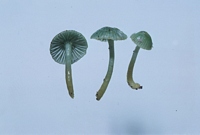
Owner: Herb. PDD | 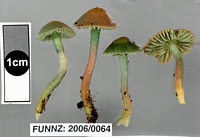
Caption: FUNNZ: 2006/0064, See public note for more information
Owner: FUNNZ | 
Caption: Often common in swarms across forest floor. Clevedon Scenic Reserve, 10 August 2007.
Owner: Samantha Happy | 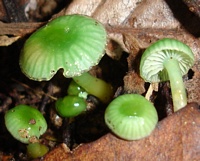
Caption: Clevedon Scenic Reserve, 10 August 2007.
Owner: Samantha Happy | 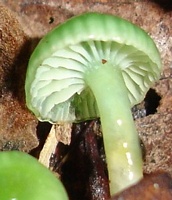
Caption: Clevedon Scenic Reserve, 10 August 2007.
Owner: Samantha Happy | 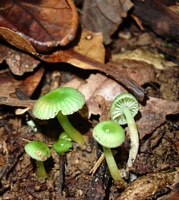
Caption: Clevedon Scenic Reserve, 10 August 2007.
Owner: DSC00004_2.JPG | 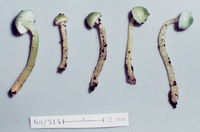
Caption: ZT68-514
Owner: E. Horak: © Creative Commons Attribution-Noncommercial 3.0 New Zealand | 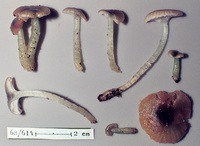
Caption: ZT68-614
Owner: E. Horak: © Creative Commons Attribution-Noncommercial 3.0 New Zealand | 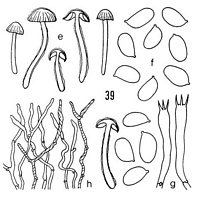
Caption: Gliophorus viridis (Stev.): e. carpophores. - f. spores. - g. basidia. - h. cuticle (Herb. HK. ZT 68/518) | 
Caption: Fig. 36 Gliophorus viridis (Stev.) Horak(T-V:ZT 68/514): T. basidiomes.
U. spores. V. basidia. (K338, type): W. spores. | 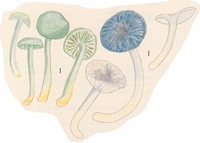 | 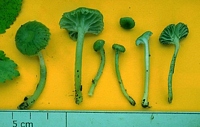
Caption: Mount Egmont, North Island, 1999-04-29
Owner: Karl Soop | 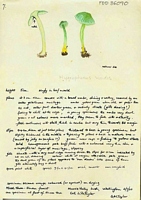
Caption: Watercolour
Owner: G.M. Taylor | 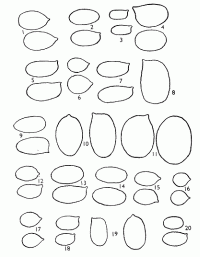
Caption: Spores X 2000 1. Hygrophorus salmonipes 2; H. elsae; 3, H .julietae; 4, H. variabilis; 5, H. lilaceo-lamelllatus; 6, H. muritaiensis; 7, H. keithgeorgei; 8, H. pseudococcineus; 9, H. rubro-carnosus; 10, H. miniceps; 11, H. procerus; 12, H. multic |
Article: Horak, E. (1990). Monograph of the New Zealand Hygrophoraceae (Agaricales). New Zealand Journal of Botany 28(3): 255-306 (http://www.rsnz.org/publish/abstracts.php).
Description: Pileus -15(-35) mm, hemispherical becoming convex to expanded; green to malachite
green, darker at centre, fading with age; glutinous, hygrophanous, striate at
margin. - Lamellae 8-12 (1 -3) subdistant, adnate to subdecurrent with short
tooth; pale green fading to whitish, edges concolorous, entire, without glutinous
thread. - Stipe 15-50 x 2-3 mm, cylindrical, equal; green at apex, orange to
pale yellow towards base; glutinous, hollow, single. - Context green in pileus,
orange-grey in base of stipe, waxy, unchanging. - Odour slightly alkaline. -
Taste not distinctive. – Chemical reactions on pileus: KOH - yellow.
Spores 7-8 (-9) x 4-5 um, ellipsoid. - Basidia 35-45 x 5-7 um, 4-spored. -
Cystidia absent. - Pileipellis an ixocutis of cylindrical, erect to interwoven
hyphae (2-5 um diam.), terminal cells branched, membranes strongly gelatinised,
with plasmatic pigment; clamp connections present (Pl. 1, Fig. 6).
Habitat: ECOLOGY: Scattered; saprobic on soil among litter in broadleaved-conifer forest
(Nothofagus fusca, Elaeocarpus sp., Dacrydium cupressinum). May-June.
Distribution: DISTRIBUTION: NZ (W, SL). -Australia (NSW, VIC ?; cf. Young 1986).
Article: Horak, E. (1971). A contribution towards the revision of the Agaricales (Fungi) from New Zealand. New Zealand Journal of Botany 9(3): 403-462 (http://www.rsnz.org/publish/abstracts.php).
Notes: Hygrophorus viridis Stevenson (28 D) = Gliophorus viridis (Stevenson) comb.
nov. (Basionym: H. viridis Stevenson, Kew Bull. 16: 383, 1962)
Article: Stevenson, G. (1963) [1962]. The Agaricales of New Zealand: IV. Kew Bulletin 16(3): 373–384.
Description: Pileus 1-5-3.5 cm. diam., herbage green to melachite
green, occasionally blue with pink tints, striate at margin, very slimy, convex
becoming flattened, with or without a shallow umbilicus; flesh concolorous.
Gills adnate to subdecurrent, moderately thick, concolorous with a white bloom.
Stipe 3-5 cm. X 3-5 mm,, concolorous above, yellow at base, hollow to somewhat
stuffed, very slimy. Spores 4-5 x 6-8 µm., oblong hyaline. Basidia 35 x 4-6
µm., four-spored. All specimens become flesh coloured when dried.
Habitat: habitat: under forest among moss or litter, Levin, 20.4.1948,
Stevenson; & 26.6.1948, F. Duguid, Keith George Park, Wellington, 15.6.1949,
Stevenson; Rotoiti, 16.5.1956, E. Kidson; Nelson, 3.6.1956, Stevenson.
Notes: This species is close to the European H. psittacinus (Schaeff. ex Fr.)
Fr, which is a toadstool of grassland, whilst H. viridis has been found
only in forest. The New Zealand fungus does not go brown and does not have
brown or red colour on the cap; also its spores are slightly smaller.
Article: Horak, E. (1973). Fungi Agaricini Novazelandiae I-V. Beihefte zur Nova Hedwigia 43: 200 p.
Description: Pileus 10-15(-35) mm diam., hemispherical when young becoming convex or even expanded, herbage green to malachite green, darker at the centre, glutinous, striated at the sharp margin. Lamellae adnate to subdecurrent, whitish-greenish, moderately close, gill edge even, concolorous, without gelatinous thread. Stipe 15-50 x 2-3 mm, cylindric, equal, apex concolorous with pileus, orange-grey to yellowish towards the base, glutinous except uppermost portion, hollow, single. Context green in pileus, orange-grey at the base of the stipe, unchanging. Odor slightly alkaline. Taste mild. Chemical reactions on pileus: KOH - yellow.
Spores 7-8(-9) x 4-5 µm, ellipsoid, smooth, inamyloid. Basidia 35-45 x 5-7 µm, 4-spored. Cystidia lacking. Cuticle an ixotrichodermium consisting of erect, cylindric, apically branched hyphae (2-5µm diam.), membranes strongly gelatinized, thin-walled. Clamp connections numerous.
Habitat: On soil in broadleaf forest (Fuchsia, Melicytus), Podocarpus, Dacrydium, etc. New Zealand.
Notes: This beautiful species (see Taylor 1970) differs from G. graminicolor Hk., another green coloured Hygrophoraceae from New Zealand, in its adnate (!) lamellae, larger spores, and absence of an unpleasant odor.
|